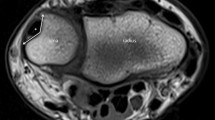Abstract
Purpose
In this study, using an ultrasonography, we investigated the positional relationship between the volar bone cortex of distal radius and flexor pollicis longus (FPL) tendon in the distal radius of healthy subjects.
Methods
The subjects were 32 healthy volunteers (56 wrists) (Age 32.9 ± 8.5, 16 males and 16 females). Their wrists were imaged by an ultrasonography. The distances between the watershed line (WS) and FPL (A), between the distal margin of pronator quadratus (DMPQ) and FPL (B), between the FPL and volar radial bone cortex at the maximum muscle belly of the PQ muscle right below the sliding region of the FPL tendon (C), and between the WS and DMPQ (D) were measured.
Results
All these parameters showed a normal distribution. When the correlation among the parameters was investigated, a correlation with an index of the physique, BMI, was noted in A (P < 0.01), B (P < 0.01), and C (P < 0.01), but no correlation was noted only in D (P = 0.59).
Conclusions
Our results were suggested that when distal radius fracture is treated with a distal plate placement, the appropriate placement can be achieved by applying about 3 mm additional dissection of soft tissue on the volar bone cortex distal to the DMPQ.



Similar content being viewed by others
Change history
05 March 2022
A Correction to this paper has been published: https://doi.org/10.1007/s00276-022-02908-9
References
Asadollahi S, Keith PP (2013) Flexor tendon injuries following plate fixation of distal radius fractures: a systematic review of the literature. J Orthop Traumatol 14:227–234
Cross AW, Schmidt CC (2008) Flexor tendon injuries following locked volar plating of distal radius fractures. J Hand Surg Am 33:164–167
Goorens CK, Van Royen K, Grijseels S, Provyn S, De Mey J, Scheerlinck T, Goubau JF (2018) Ultrasonographic evaluation of the distance between the flexor pollicis longus tendon and volar prominence of the plate as a function of volar plate positioning and pronator quadratus repair—a cadaver study. Hand Surg Rehabil 37:171–174
Imatani J, Akita K, Yamaguchi K, Shimizu H, Kondou H, Ozaki T (2012) An anatomical study of the watershed line on the volar, distal aspect of the radius: implications for plate placement and avoidance of tendon ruptures. J Hand Surg Am 37:1550–1554
Kadoma C, Takahara M, Maruyama M, Satake H, Takagi M (2017) Ultrasonographic assessment of the flexor pollicis longus tendon after plate fixation. Orthopedics 40:e104–e108
Kwon BC, Lee JK, Lee SY, Hwang JY, Seo JH (2018) Morphometric variations in the volar aspect of the distal radius. Clin Orthop Surg 10:462–467
Limthongthang R, Bachoura A, Jacoby SM, Osterman AL (2014) Distal radius volar locking plate design and associated vulnerability of the flexor pollicis longus. J Hand Surg Am 39:852–860
Nanno M, Kodera N, Tomori Y, Takai S (2016) Transverse ultrasound assessment of the flexor pollicis longus tendon movement on the distal radius during wrist and finger motion in distal radius fracture with volar plating. J Med Ultrason (2001) 43:29–36
Nanno M, Kodera N, Tomori Y, Takai S (2018) Ultrasonographic movement of the flexor pollicis longus tendon before and after removal of a volar plate for the distal radius fracture. J Orthop Surg 26:2309499018760131
Orbay JL, Touhami A (2006) Current concepts in volar fixed-angle fixation of unstable distal radius fractures. Clin Orthop Relat Res Apr 445:58–67
Soong M, van Leerdam R, Guitton TG, Got C, Katarincic J, Ring D (2011) Fracture of the distal radius: risk factors for complications after locked volar plate fixation. J Hand Surg Am 36:3–9
Tanaka Y, Aoki M, Izumi T, Fujimiya M, Yamashita T, Imai T (2011) Effect of distal radius volar plate position on contact pressure between the flexor pollicis longus tendon and the distal plate edge. J Hand Surg Am 36:1790–1797
Tanaka Y, Gotani H, Yano K, Sasaki K, Hamada Y (2017) Evaluation of flexor pollicis longus tendon attrition using color Doppler imaging after volar plate fixation for distal radius fracture. J Orthop Sci 22:447–452
Vosbikian MM, Ketonis C, Huang R, Ilyas AM (2016) Optimal positioning for volar plate fixation of a distal radius fracture: determining the distal dorsal cortical distance. Orthop Clin N Am 47:235–244
Yamazaki H, Uchiyama S, Komatsu M, Hashimoto S, Kato H (2015) Risk assessment of tendon attrition following treatment of distal radius fractures with volar locking plates using audible crepitus and placement of the plate: a prospective clinical cohort study. J Hand Surg Am 40:157–181
Author information
Authors and Affiliations
Contributions
Protcol/project development was performed by KN and YI. Data collection or management was performed by MK, KG, YS, HO, and NN. Data analysis was performed by MK, KG, YS, HO, NN, and KN. Manuscript writing/editing was performed by MK, KK, and KN.
Corresponding author
Ethics declarations
Conflict of interest
The authors declare that they have no conflict of interest.
Additional information
Publisher’s Note
Springer Nature remains neutral with regard to jurisdictional claims in published maps and institutional affiliations.
In the original publication of the article, there are two errors under the section heading “Materials and methods” on P 786 has been incorrectly published. First error in ethical approval ID, P 786, Line 2–4 and the second error in the subject information that given in “Materials and methods” section, P 786, Line 5–11.
Rights and permissions
About this article
Cite this article
Kinoshita, M., Naito, K., Goto, K. et al. Anatomical–positional relationship between the bone structure of the distal radius and flexor pollicis longus tendon using ultrasonography. Surg Radiol Anat 41, 785–789 (2019). https://doi.org/10.1007/s00276-019-02216-9
Received:
Accepted:
Published:
Issue Date:
DOI: https://doi.org/10.1007/s00276-019-02216-9




